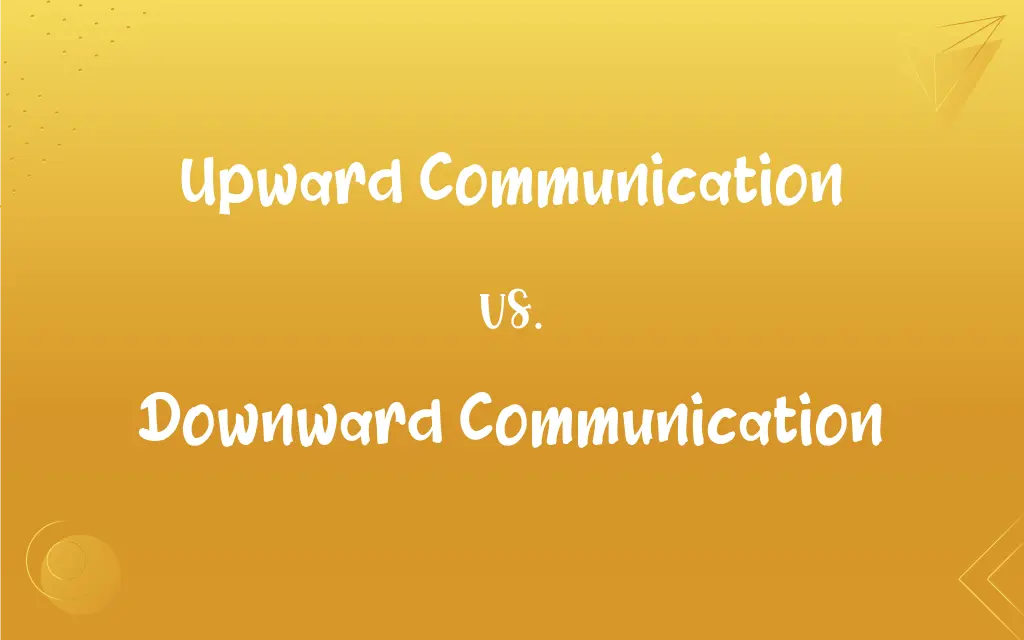Upward Communication vs. Downward Communication: What's the Difference?
Edited by Janet White || By Harlon Moss || Updated on October 7, 2023
Upward communication flows from subordinates to superiors, conveying feedback or issues; downward communication flows from superiors to subordinates, delivering instructions or policies.

Key Differences
Upward Communication is generally identified as the flow of information from lower organizational levels to the higher ones, ensuring that individuals at every tier can communicate their feedback, concerns, or suggestions to their superiors. In contrast, Downward Communication is the transmission of information from the higher echelons of the organizational hierarchy to the lower ones, often containing guidelines, policies, and procedures. Both are pivotal, yet serve divergent functional roles within a corporate framework.
When exploring Upward Communication, an emphasis is placed on the employee’s ability to voice their thoughts and concerns, thereby contributing to organizational change or policy development. Meanwhile, Downward Communication predominantly pertains to leaders instructing, informing, or updating their subordinates. The balance between both forms is imperative to maintaining a healthy, dynamic organizational structure where information can freely move in both directions.
In the realm of Upward Communication, the channels might involve surveys, suggestion boxes, or meetings, which facilitate an environment where the workforce feels heard and valued. On the flip side, Downward Communication encompasses memos, emails, and guidelines which are disseminated with the intention of guiding and managing the workforce. Both methods must be tactfully managed to prevent miscommunication or a breakdown in the flow of pertinent information.
The efficacy of Upward Communication is often gauged by how well an organization responds to and implements feedback and how safe employees feel in expressing their thoughts. Conversely, the efficacy of Downward Communication is often measured by the clarity, coherence, and applicability of the directives given by superiors. Ideally, organizations will seamlessly blend both communication forms to ensure a symbiotic relationship between all organizational levels.
Comparison Chart
Direction
From lower to higher organizational levels
From higher to lower organizational levels
ADVERTISEMENT
Purpose
To provide feedback and convey issues
To give instructions and convey policies
Examples of Communication
Feedback forms, suggestion boxes
Memos, guidelines, policy statements
Benefit
Engages employees and encourages a feedback culture
Ensures clarity of roles and expectations
Risk
Can be ignored or undervalued by superiors
Can be perceived as authoritarian or impersonal
Upward Communication and Downward Communication Definitions
Upward Communication
Upward Communication refers to the transmission of information from junior to senior levels.
The employee survey was a method of upward communication, allowing staff to express their views to management.
ADVERTISEMENT
Downward Communication
Downward Communication is the flow of information from superiors to subordinates, often in the form of directives.
The CEO used downward communication to convey the new company policy to all employees.
Upward Communication
Upward Communication involves feedback, suggestions, or complaints moving towards the higher hierarchy.
Through upward communication, the manager learned about the production floor's safety issues.
Downward Communication
Downward Communication can often be seen in memos, policies, and procedural updates.
Employees received a downward communication memo about the updates in the leave policy.
Upward Communication
Upward Communication often signifies a democratic organizational culture.
The CEO valued upward communication, often acting on ideas generated by entry-level employees.
Downward Communication
Downward Communication assists in establishing clear hierarchies and guidelines within an entity.
Effective downward communication ensured that all teams were aligned with the strategic shift of the company.
Upward Communication
Upward Communication can be formal or informal channels used by subordinates.
Town hall meetings are utilized for upward communication, encouraging open dialogue between staff and leadership.
Downward Communication
Downward Communication often represents a traditional organizational communication model.
Routine newsletters serve as a channel for downward communication, updating staff on corporate changes and achievements.
Upward Communication
Upward Communication aims to facilitate a two-way conversation within the organization.
The introduction of a suggestion box improved upward communication, providing employees a voice in company initiatives.
Downward Communication
Downward Communication ensures that organizational expectations and guidelines are clearly disseminated.
Through downward communication, employees were made aware of the new reporting structures.
FAQs
Can downward communication negatively impact an organization?
Yes, if downward communication is excessively authoritarian or lacks clarity, it can demotivate employees and create a stifling work environment.
What is the primary purpose of upward communication?
Upward communication primarily aims to convey feedback, concerns, or suggestions from subordinates to superiors.
How is downward communication typically manifested within organizations?
Downward communication is often manifested through policies, directives, and instructions issued by superiors to subordinates.
How does upward communication benefit an organization?
Upward communication fosters an inclusive environment, drives employee engagement, and can provide valuable insights for management decision-making.
Is downward communication still relevant in flat organizational structures?
Yes, downward communication remains relevant to convey overall organizational goals, policies, and critical information, even in flat structures.
What is a common challenge associated with downward communication?
Ensuring that messages are clear, consistent, and well-received across all levels of the organization is a common challenge in downward communication.
How can organizations enhance the effectiveness of upward communication?
Organizations can enhance upward communication by encouraging feedback, ensuring anonymity where necessary, and demonstrating that they value and act upon the input received.
What is a practical example of upward communication?
Employees providing feedback regarding a new workflow process, offering insights, and suggesting improvements is an example of upward communication.
How does downward communication support organizational objectives?
Downward communication ensures all members understand their roles, expectations, and the strategic goals of the organization, facilitating coordinated efforts.
How can technology influence upward communication?
Technology, like internal communication platforms, can streamline and enhance upward communication, making it more accessible and organized.
Can downward communication be interactive?
While traditionally more directive, downward communication can be interactive through Q&A sessions, forums, or integrating feedback mechanisms.
How does downward communication align with organizational structure?
Downward communication often mirrors the organizational structure, flowing from top-level management down through the various hierarchical levels to the front-line employees.
Can upward communication be informal?
Absolutely, upward communication can be informal, such as casual conversations, and can be equally as valuable as formal channels like surveys or official meetings.
How does culture impact upward communication?
Organizational culture significantly impacts upward communication; an open culture promotes it, while a hierarchical culture may restrict it.
What role does downward communication play in crisis management?
Downward communication is crucial in crisis management to provide clear guidelines, reassure employees, and coordinate a unified organizational response.
How do organizations typically facilitate upward communication?
Organizations facilitate upward communication through feedback forms, suggestion boxes, employee forums, and encouraging an open-door policy among managers.
Why is consistency important in downward communication?
Consistency in downward communication ensures uniform understanding, prevents confusion, and maintains organizational stability and trust.
What is a potential risk of excessive upward communication?
Excessive upward communication can potentially overwhelm management with information, making it challenging to identify and act upon priority issues.
How should leaders approach downward communication to avoid demotivation?
Leaders should ensure downward communication is clear, constructive, and includes rationales behind decisions or policies to foster understanding and buy-in.
Can upward communication influence organizational change?
Yes, upward communication often brings forth employee insights that can drive improvements and significant organizational change.
About Author
Written by
Harlon MossHarlon is a seasoned quality moderator and accomplished content writer for Difference Wiki. An alumnus of the prestigious University of California, he earned his degree in Computer Science. Leveraging his academic background, Harlon brings a meticulous and informed perspective to his work, ensuring content accuracy and excellence.
Edited by
Janet WhiteJanet White has been an esteemed writer and blogger for Difference Wiki. Holding a Master's degree in Science and Medical Journalism from the prestigious Boston University, she has consistently demonstrated her expertise and passion for her field. When she's not immersed in her work, Janet relishes her time exercising, delving into a good book, and cherishing moments with friends and family.































































